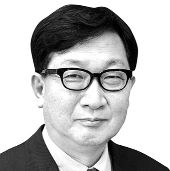Fostering our new industries holds the key

Kim Jung-sik
The author is an emeritus professor of economics at Yonsei University.
The Korean economy is still stuck with its low growth and shows no sign of recovery. The government forecasted slow growth in the first half and a gradual rebound in the second half, primarily thanks to an increase in exports and consumption after the economy recovers from the pandemic-driven slump. But the International Monetary Fund and the Organisation for Economic Cooperation and Development lowered their outlooks for this year’s growth rate of the Korean economy given its export contraction for the 10th straight month in July and the worsening external and internal environments for the economy.
What concerns me first is the possibility of additional rate hikes by the Federal Reserve and the European Central Bank — and their consolidation in the United States and Europe. The Fed has been in an uphill battle with sticky inflation, basically stemming from high wages from labor shortages. That’s why the Fed is expected to raise the benchmark rate again after September and keep rates high at least until the first half of next year. That will slow the recovery of the global economy, reduce Korea’s exports and delay its economic recovery.
Another concern comes from the bursting of China’s property bubble and a following recession. On a crusade to rebuild the China-centered global supply chains, the United States pursues a decoupling from the country by increasing the share of domestically-produced strategic items like semiconductors. As a result, China’s outbound shipments declined by 14.5 percent in July, including a whopping 23.1 percent cut in its exports to the United States.
The exports reduction may prompt a huge property bubble burst in China with resulting insolvencies. Thanks to China’s de facto closed capital market, the impact of the bubble burst could be limited. But given the sheer weight of China in the global economy, it can certainly shake the global financial market, including Korea’s, in particular.

Economists find similarities between China’s economy now and Japan’s in the late 1980s. At that time, the United States took the drastic measures of restricting its semiconductor imports from Japan — which covered more than 70 percent of global chip supplies at the time — and of appreciating the yen exponentially. That led to the bursting of the real estate bubble, a long recession and deflation in Japan.
China, already in a slump from strengthened import restrictions by the United States, shows tangible signs of deflation, as seen in the negative 0.3 percent growth in its consumer price index for July. If the slump is deepened, Beijing could be tempted to lower the yuan’s value against the U.S. dollar. If Asian countries rush to another round of foreign-exchange war, Korea’s export could be dealt a critical blow.
The Korean economy recovering at a snail’s pace can be attributed to its weakening industrial competitiveness. So far, Korea has maintained trade surplus by increasing exports to China. But in the face of China’s rapid catchup, Korea’s competitiveness in the shipbuilding, steelmaking and petrochemical sectors has noticeably weakened, as seen in the cases of cars and electronic products today. If that’s the reason for Korea’s slowed exports, its shipments to China will not likely recover, even if China recovers from a recession.
Stagnant domestic demand is another factor to slow the recovery speed of the Korean economy. Due to households’ snowballing debt from high interest rates and their ever-higher cost of living, they cannot spend as before. On companies’ part, it’s also not easy to increase investment amid a recession and wage hikes.
To put low growth and a recession behind us, the government often uses macroeconomic policies such as monetary, fiscal and foreign exchange tools. But it’s not easy to use them this time due to the government’s worry about capital flight from a widening gap between the Korean won and the U.S. dollar if it lowers interest rate to stimulate the economy. Moreover, if the Bank of Korea (BOK) lifts the base rate, inflation could pick up from its barely stabilized 2 percent level.
If the BOK chooses to raise the base rate, it could exacerbate the recession and insolvency in the corporate sector. The government cannot use fiscal tools as it will aggravate fiscal health further. Foreign exchange rate policy is no exception. To increase exports, the central bank must lift the exchange rate. But if so, import prices will rise to fuel inflation. If such policy means are restricted, the economy could be heading to a crisis.
How can we save the economy stuck in the double whammy of recession and low growth and revitalize it? First of all, the government must find the answer from its past industrial policy. Korea’s economic problems largely originate from its weakened industrial competitiveness. After the 1997-98 foreign exchange reserve crisis, the country could still achieve high growth thanks to the relatively high competitiveness of its mainstay industries, including the chip sector, after the transfer of related technologies from Japan. But since the rapid catchup by China, even Korea’s trade balance has worsened. The trade surplus Korea had enjoyed owed more to either the intermittent surge in chip demand or to a reduction in imports than its heightened competitiveness.
To elevate the competitiveness, the government must foster new industries. After having trouble finding new growth engines that could replace existing industries, Japan experienced a recession for three decades. Despite deepening concerns about Korea taking the same path as Japan, Korea’s remarkable progress in the battery, bio, artificial intelligence, electric car and defense industries raise the hope that the economy can take another leap forward if it elevates the competitiveness of cutting-edge industries. It’s time to change the structure of our industry to meet the challenges from the fourth industrial revolution.
To cultivate new industries, the government must increase spending on raising talents to develop new technologies. To achieve this goal, it must reinvent the university education and state-funded research systems designed for the economy of the past.
The government must draw up its signature policy focused on new industries and raise the level of public understanding of its initiative, as past governments did — for instance, the “green growth” under the Lee Myung-bak administration, the “creative economy” in the Park Geun-hye administration, and the “income-led growth” under the Moon Jae-in administration. New industrial policy will not only enable the economy to escape from the low-growth trap by elevating its industrial competitiveness over the long term, but can also help the economy break away from a recession by attracting corporate investment thanks to its clearer economic vision in the short run.
Exports hold the key to bolting out of low growth. To do that, the government must push policies to diversify external markets. Korea’s overreliance on China for exports plunged to 19 percent recently, but the share is still high. If Korea’s exports to China decreases under such circumstances, its trade deficit will swell to worsen its current account balance.
The government must proactively deal with Korea’s exports drop with China by expanding its exports frontiers to Southeast Asia, South America, Eastern Europe and the Middle East. To achieve this goal, it needs to revitalize the export strategy meeting presided over by the president, including holding the meeting more often and inviting major corporate leaders. Improving the current account balance through increased exports is important for the success of the government’s labor, education and pension reforms, too. Domestic reform can only be pushed without the risks of foreign exchange and financial crises.
Finally, flexible operation of fiscal policy is essential. In an open economy with the free flow of capital, the government should be wary of a continuous high interest rate and hard landing of the economy, which can lead to a financial crisis or foreign exchange crisis starting with mounting insolvencies and plunging property prices. The government lowered this year’s growth outlook to 1.4 percent from last year’s 2.6 percent.
The Korean economy faces a watershed moment from the ongoing realignment of global supply chains, the slowed growth of the Chinese economy, and the emergence of cutting-edge industries. The bursting housing bubbles in China only fuels uncertainties in Korea’s financial market. The time has come for the government to make a prudent yet wise choice to get the economy out of a long tunnel of low growth.
Translation by the Korea JoongAng Daily staff.










with the Korea JoongAng Daily
To write comments, please log in to one of the accounts.
Standards Board Policy (0/250자)